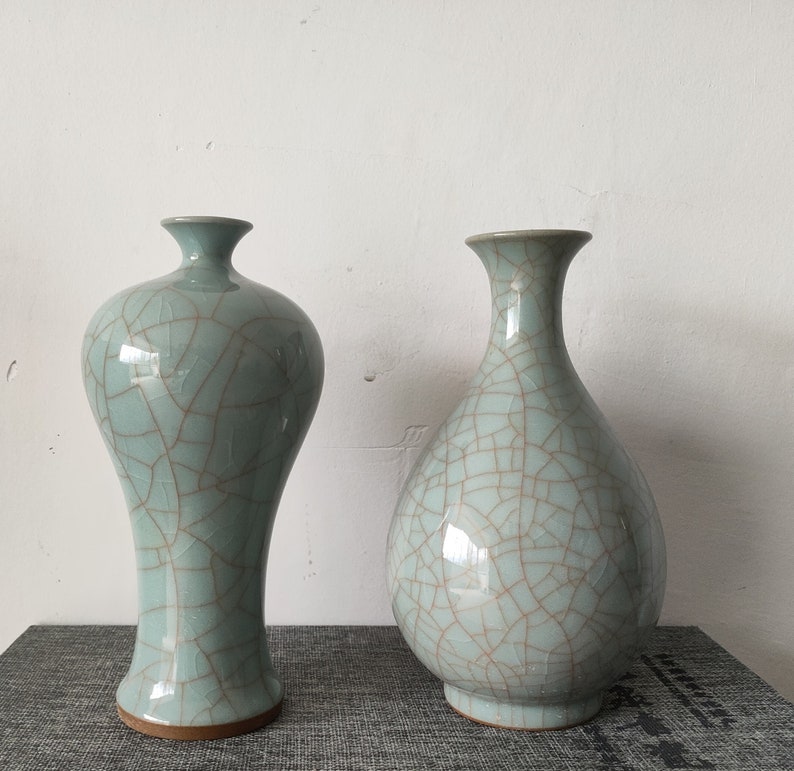Ge kiln Handmade Celadon Vase Set Antique Home Decor Personalized gift Ice Crack Craft(two vases 2024 as a set)
Note: The handmade works are subject to the actual product, the packaging is very careful, and the transportation is safe, please rest assured
Vintage Chinese porcelain celadon vase. A vintage Chinese celadon vase, circa 1960s, with a good level of detail in the design. Excellent color! This is a porcelain vase about 20 cm high. Made with ice crack craftsmanship, it's perfect.
This ancient Chinese piece is well preserved and shows no signs of damage.
-------------------------------------------------- -------------------------------------------------------
The technological process of Longquan celadon consists of nine steps: ingredients, molding, blanking, decoration, glazing, firing, boxing, kiln loading, and firing. Among them, glazing and biscuit firing are very distinctive.
Glazing: It can be divided into several steps, such as placing glazing, dipping glazing, glazing, and spraying glazing. Thick glazed products usually require several layers of glaze, one bisque firing, then glaze, and then bisque firing. This can be repeated four to five times. Before entering normal firing, more than ten layers of glaze are applied at most.
Biscuits: The temperature of biscuit is relatively low, generally around 800 degrees Celsius. The glaze is fired at about 1200 degrees Celsius, and the temperature is gradually increased and controlled as required to control the atmosphere in the kiln, and finally the finished product is fired. From the Southern Song Dynasty to the early Yuan Dynasty, Longquan kiln once fired thin-bodied original glaze porcelain.
The last layer of glaze is fired once, and the thickness can reach more than ten layers
Chinese celadon is traditionally divided into "ge kiln" and "earth kiln". The saying about brother kiln comes from records in the Ming Dynasty: "The brothers of Zhang's family in Longquan County, Chuzhou, are good at tube porcelain.
The pottery name of Zhang Sheng and his wife is Zhang Longquan, also known as Brother Kiln. Zhang Shengyi's brother kiln. And his brother. "Really have two brothers?, no test,
But it illustrates two different Longquan celadon products: one is white-body cinnabar-body celadon, called "Di Kiln" or "Longquan Kiln", and the other is glazed-mouth black-body celadon,
Called "Ge Yao".
"Ge Kiln" appeared in the middle and late Southern Song Dynasty, and together with the famous Guan, Ru, Ding and Jun, it was called the five famous kilns in the Song Dynasty. Iron feet, grey-black tire color. "Ge Kiln" with Ice Cracks
, crab claw pattern, cow hair pattern, flowing water pattern, caviar pattern, blood-eating pattern, garbage and other gorgeous and simple patterns as decorative means. .The glazed patterns complement each other, making it more concise and elegant.
Such products win in terms of shape, glaze color, and glaze mouth. Since the opening is not easy to be controlled by humans, and the cracks are unintentional and natural, the use of natural craftsmanship is more in line with the aesthetics of nature, simplicity and simplicity.
The "earth kiln" is dominated by white glaze blue, with the most powder green and plum green, followed by bean green, and is known as the master of folk kilns. The small earth kiln has rich glaze layers, emerald green glaze and soft luster.
Crystal clear and moist, better than jade. The verdant glaze is paired with an orange-red sole or exposed tire tread for a visually pleasing effect. In the middle and late Southern Song Dynasty, especially the Yuan Dynasty,
A large number of works using exposed tires have appeared. Characters' faces, hands, feet, clouds, dragons, flowers, etc.
Modern Longquan celadon faithfully inherits the traditional Chinese artistic style. On the basis of inheritance and antique,
There are new breakthroughs, and the research has successfully completed copper glaze, high 2024 temperature black glaze, tiger pattern glaze, Hecai glaze, and brown glaze. , black gold glaze, blue glaze, etc.




